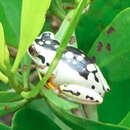Description
provided by AmphibiaWeb articles
A large species of Heterixalus with variable coloration and obvious sexual color dimorphism; males are 26-31 mm and females are 25-33 mm in total length. Males are without conspicuous coloration: the back is uniformly colored, or with indistinct dark markings, or with two light dorsilateral bands. Females are beige to bright yellow, with large distinct black markings, which sometimes fuse, leaving only three longitudinal yellow bands. The venter is whitish. Thighs, ventral surface of limbs, hands and feet are orange.Similar species: Because of the colouration variability of H. "variabilis", it can be confused with many other species of Heterixalus. However, because of the apparently restricted distribution area (Sambirano region), confusion is only likely with H. tricolor, which differs in coloration.Taken with permission from Glaw and Vences (2007).
Nussbaum, R., Vences, M., and Glaw, F. (2008). Heterixalus variabilis. In: IUCN 2008. 2008 IUCN Red List of Threatened Species. www.iucnredlist.org. Downloaded on 21 April 2009.
- author
- Miguel Vences
- author
- Frank Glaw
Distribution and Habitat
provided by AmphibiaWeb articles
Ambanja, Ambilobe, Benavony, Nosy Faly (TL). It occurs below 200m asl in open areas, agricultural land, urban areas, swamps, and rice paddies (Nussbaum et al. 2008).
- author
- Miguel Vences
- author
- Frank Glaw
Life History, Abundance, Activity, and Special Behaviors
provided by AmphibiaWeb articles
Calls: Typically one long and one short note, often followed by a second such series. The typical call can be described as "eeep-ep--eeep-ep". Two unharmonious note types are present: first type lasts 90-110 ms: second type is shorter, ca. 30 ms. Intervals after note type 1 are about 100 ms and notes are arranged in groups, usually as "1-2-1-2". Other combinations are "1-2" and "1-2-1-2-1-2", rarely "1-2-2". Frequency ranges from 3 to 4 kHz. Collected males sometimes used a third type of note (duration about 1000 ms), a large unharmonious sound, often followed by one or two short clicks. This note resembles note type 1 of H. madagascariensis, and possibly has a territorial function. Calling males were found during the evening and night, in swamps and rice fields without substantial tree cover, together with Boophis tephraeomystax, Ptychadena mascareniensis, Hoplobatrachus tigerinus, and Mantidactylus wittei.Breeding occurs in permanent and temporary still waters (Nussbaum et al. 2008).
- author
- Miguel Vences
- author
- Frank Glaw
Life History, Abundance, Activity, and Special Behaviors
provided by AmphibiaWeb articles
It is not known from any protected areas (Nussbaum et al. 2008).
- author
- Miguel Vences
- author
- Frank Glaw
Heterixalus variabilis: Brief Summary
provided by wikipedia EN
Heterixalus variabilis is a species of frog in the family Hyperoliidae endemic to Madagascar. Its natural habitats are moist savanna, subtropical or tropical seasonally wet or flooded lowland grassland, swamps, freshwater marshes, intermittent freshwater marshes, arable land, urban areas, heavily degraded former forests, ponds, irrigated land, seasonally flooded agricultural land, and canals and ditches.
- license
- cc-by-sa-3.0
- copyright
- Wikipedia authors and editors

